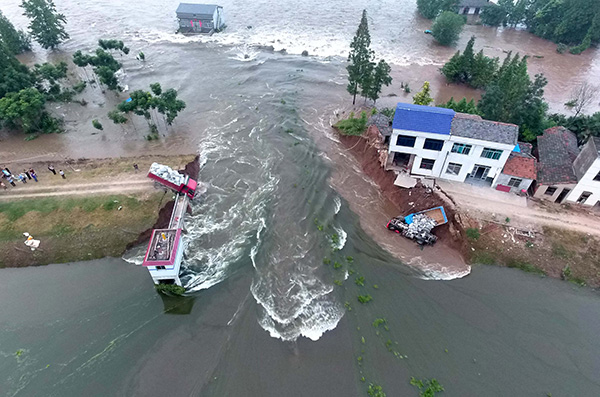 |
|
Trucks loaded with stones fell into the gap of a broken dike in Huarong county, Hunan province, on Sunday. Drivers had to jump seconds before their vehicles were engulfed by the water. LI GA/XINHUA |
It is a little-known fact among general public and politicians that floods cause more damages each year globally than any other form of natural disasters. According to the United Nations, over the 20-year period between 1995 and 2015, 157,000 people died due to floods and another 2.3 billion were affected.
Currently, global average annual flood losses are estimated at $104 billion. The country incurring the highest losses is China, followed by US and India. These losses do not include disruptions to global supply chains when industries located in flood plains are often affected by floods. The 2011 flood in Thailand first brought this problem to global attention. However, the country which has the potential to disrupt the global supply chains the most because of floods is China, followed by Brazil, Russia and India.
Because of topography, high population, urbanization and tremendous economic growth during the past decades, China has had three of the 10 most costly global floods since 1950. Equally, because of population density, all the three Chinese floods resulted in high fatalities compared to the other seven floods elsewhere where deaths were in hundreds.
At global number two is the July-August flood of 1998, which resulted in 3,656 deaths and an economic loss of $43.7 billion in 2014. The sixth costly global flood was also in China, during July-August 2010. It caused 829 deaths and losses of 31.1 billion in 2014. In the 10th place is the flood of June-July 1996 which caused 2,775 deaths and an economic damage of $19 billion in 2014.
Flooding has been a perennial problem in China. Earlier one of the important tests of good rulers was their ability to protect the citizens from the ravages of floods. This requirement continues even today.
The good news is that death toll from floods in China has steadily declined due to government actions such as construction of dams, dikes and levees, early warning systems and prompt evacuation measures. The bad news is, economic costs of floods are steadily increasing and are likely to rise in foreseeable future.
It appears that the 2016 floods are likely to enter in Chinese record books as one of the most severe ones. The floods season is not yet over. Damages incurred are already significant. This is primarily because rainfall in China this year has been 21 percent higher than average. In Yangtze Basin, it has been 27 percent higher than average.
Yangtze is the longest river of China and the third-longest in the world. It is also the most important water artery in terms of economy and development. Thus, a serious Yangtze flood has major implications not only for China but also for the world by disrupting manufacturing and transportation links as well as the global supply chain.
According to the Office of State Flood Control and Drought Relief Headquarters, as of July 3, 32 million people in 26 provinces have been affected, 186 have died, 26 are missing, and 1.4 million people have been relocated. Some 73,000 homes have collapsed and crops have been lost in 700,000 ha. Direct economic losses already exceed $10 billion. Flood season does not end until August.
The severe flood this year was not unexpected. Vice-Premier Wang Yang had warned in June that El Ni?o this year was likely to increase flooding risks significantly in Yangtze and Huai basins. In 1998, another El Ni?o year, the death toll reached 3,556. With better preparedness, human losses this year are likely to be significantly less.
In terms of national policies, flooding was recognized to be a major problem during the post-1995 period when each of the two floods in 1996 and 1998 caused several thousand deaths and billions of dollars on economic damages. While floods became a serious concern, the solutions then proposed went only part way to solve the problem. This main policy was to construct large dams which could effectively store flood waters. After the flood seasons, stored excess water could be used during months of no, or limited, rainfall to generate hydroelectricity and then used for agriculture, industrial and domestic purposes. Major dams like Three Gorges were constructed, having flood control as an important objective.